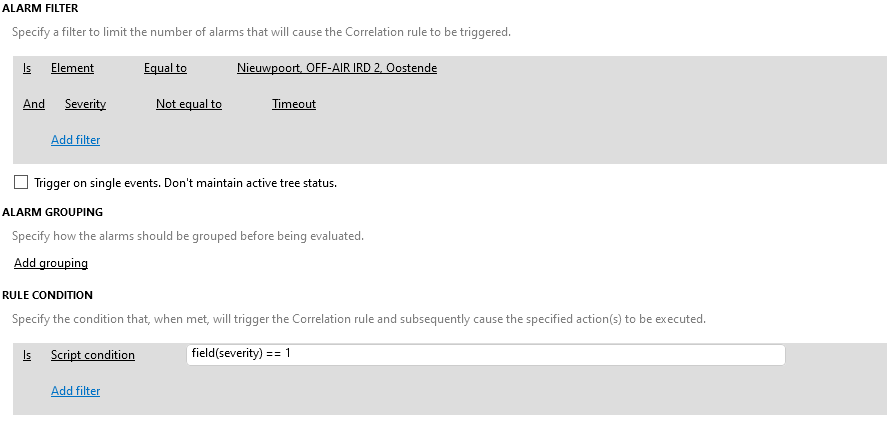What is the correct syntax for a correlation rule script condition to count the number of alarms in a bucket with a certain severity?
Use case: I have 5 IRD elements receiving a carrier from the same transmitting antenna. I want to trigger the correlation rule (to switch to another antenna) if all IRDs that are not in timeout give a critical alarm on their lock state.
Was thinking of a script condition like this: count(severity(critical)) == 5 – count(severity(timeout)) but I’m stuck on syntax…
Jochen,
Here is how to tackle your use case:
- Configure the ALARM FILTER to only capture critical alarms from the lock state parameter and timeout alarms as well
- Configure 2 script conditions (combine them with an AND operator) :
- condition 1 : count(*)>=3
- condition 2 : max(field(severity)) == 1
- critical alarm => severity = 1 ( see slenumvalues table )
- timeout alarm => severity = 17 ( see slenumvalues table )
You can find more information about syntax and limitations on docs
UPDATE : my initial suggestion is not fully in line with what is requested.
That use case ( if I now fully understood it ) could be tackled by using 2 correlation rules:
1. First rule will generate 1 correlated alarm per IRD Element
- ALARM FILTER: IRD protocol / Critical on Lock Status/ Timeout
- ALARM GROUPING : group per Element
- Action : New Alarm (highest Severity of sources Alarms )
2. Second rule will only capture correlated alarms and make sure we have same amount of correlated alarms as number of IRDs, and that at least one alarm has max severity equals to critical
- Details: Accept Correlation Alarms
- ALARM FILTER : relevant filter to only accept correlation alarms generated by previous rule
- RULE CONDITION :
- count(*)>=3 ( if 3 IRDs)
- min(field(severity)) == 1
According to Docs, counting the number of alarms part of a bucket and in a specific state is not supported :
“When script conditions use functions, fields or properties outside the min/max/avg aggregated functions context, values will be retrieved from one of the alarms in the bucket only. This will typically be the triggering alarm or the most recent one in the rule bucket.”
I’ve suggested an alternative in my initial reply
The approach with the 2 correlation rules does the trick! Thanks a lot, that’s what I was searching for.
Hi Jochen,
Maybe not the answer you are looking for, but you could also create a service in DataMiner to represent that physical antenna based on information received via the batch of IRDs linked to it.
you could exclude your devices in timeout to avoid them impacting the service state.
If you do not want timeouts to be included in the alarm status of the service, clear the checkbox Include timeouts in alarm status of the service. By default, this option is selected.
reference: Adding a service | DataMiner Docs
You can now configure the service using conditions for the alarm impact to only allow impact when all 5 of your IRD lock state parameters are failing.
This service is now representing a basic form of your Antenna reception quality. You could further extend this service to make it smarter and expose also other metrics to build. you could even go with a service template, and make it easy to visualize your complete antenna park.
Have fun 😉
need a recap on creating services? Please have a look here:
Rui’s Rapid Recap – Creating a service – DataMiner Dojo
Nice alternative! Going to try that!
Having a service representing your antenna is also a good opportunity to add a Visual that can serve to link towards other useful information in regards to your antenna. (location data, weather data, Spectrum analysis of your RF signals and many more)
FYI, I’d still like to know the syntax for the correlation rule. When doing it with a service like you described, I require quite some conditions (amount is growing fast with the number of devices in the service)
Hi Jochen,
I think you can achieve this as follows:

By adding the “Severity not equal to Timeout” in the alarmfilter section all the timeout alarms are filtered out.
The script condition makes sure that the correlation rule gets triggered when all base alarms are critical except for the elements which are in timeout.
Thanks for the advice. That’s not what I’m searching for unfortunately. With your rule it triggers already if there’s only 1 IRD element giving an alarm. It should only trigger if all are unlocked/give alarm.
Not sure if the syntax allows it – but the exact logic required (if I understood correctly what Jochen needs) would be that the count of the timeout events summed with the count of the lock alert events matches the nbr of IRDs (in other words, if one of the IRDs has neither a time-out nor a lock alert, then the rule cannot fire off).